Janet Fisher's Blog, page 3
June 6, 2024
Going There #5: Rivers, Cliffs, the Rock, and the Hat
Rivers pass through many Irish cities but in Limerick this bold, beautiful river holds the center.

The River Shannon, longest river in Ireland, flows right through Limerick, shown here from Arthur’s Quay near the city’s old town. That’s King John’s castle in the distance.
I arrived in Limerick at Arthur’s Quay where many buses stop, about a two-minute walk to my Limerick hotel, The Old Quarter Townhouse. Great location. Nice hotel. This was my second base in Ireland from which I would explore special sites. Back in my Dublin hotel the man at the desk recommended the bus that brought me, and his advice was good. There in Dublin I was able to walk from the hotel to Burgh Quay, the quay on Dublin’s River Liffey where the bus picked me up, and it was a pleasant ride south through Ireland’s green fields. Dublin and Limerick both have bus stations but I was surprised that many long-haul buses had major stops on these quays along the rivers.
In Dublin a young woman had taken the bus seat beside me and slept for a while, but when she woke we began chatting, though with some difficulty. Her English was limited, and I asked where she came from. “Mongolia,” she said. I was surprised. I came to Ireland to meet the Irish and here I was meeting someone from Mongolia. I don’t think I’d ever met anyone from Mongolia before. With the help of her phone translating app she explained that she was traveling to Limerick to attend university there.
By the time we reached Arthur’s Quay in Limerick she was helping me find my way. A lovely person. She expressed a hope of meeting again, but I supposed her host family would have other things planned. And I had tours to take.
The Cliffs of Moher
My first tour from Limerick advertised stops at these magnificent cliffs as well as the mysterious Burren, a broad area where the land has turned to stone, like paving blocks covering many square miles. I had seen these sites before but, like the revisits I did out of Dublin, I wanted to visit them this time and take pictures for social media and to help in my descriptions of places my book characters go.
A thrill washed through me on seeing the Cliffs of Moher again, my third visit to this amazing place. And a perfect day to see it.

A soft wind carried the sound of bird calls. So many birds–puffins, gulls, and more–nesting in the cliff edges and soaring over the water.


Since I last visited the cliffs a stone fence has been added to the main trail overlooking the cliffs. All the way up to O’Brien’s Tower at the peak. I walked to the tower, then down around where the trail follows the tops of the most picturesque cliffs, with a less intrusive fence. Musicians added to the birdsongs. A glorious morning.
After ample time at the cliffs the tour took us to lunch at a small restaurant that did an amazing job accommodating the sudden rush from tour buses. And my quiche was excellent.
I hadn’t heard the guide talk about the Burren, and I asked him about it. They had dropped the Burren from the tour for some reason I didn’t quite understand. Something to do with small towns there having a problem handling all the big buses. A disappointment for me, but I had to let it go.
The Rock of Cashel
The next day my excursion to the Rock I would take on my own, using the public bus system. The timetable showed many stops but fortunately the bus only stopped when a passenger asked for it or someone stood waiting at the stop to get on. Most we sailed right on by. When the reader board inside the bus showed Cashel as the next stop I began to watch our surroundings more closely. On my left the great rock appeared in the midst of a broad plain, brooding clouds overhead.

The buildings weren’t there at the time of my story but I have a vital scene at the site of this great outcrop.

A short walk from the bus stop brought me to the base of the Rock. From this spot you get a much better idea of the massive boulders of mottled white limestone that curve around the height on this side, bright-green turf between the stones. I scrambled up them a ways because I needed to get the feel of the climb. It was precarious. I didn’t dare slip.

These buildings, dating back to the 12th century AD, came well after my story, but I had to go inside. A little drafty without a roof. Black rooks, cousins of the crows, seem to love it, nesting in crevices and flying overhead with their haunting cries. The whole place seems a little haunted. I suppose the many burials add to that. Some graves are ancient. Some quite new. I’m sure the place has many stories to tell.

This new visit helped me a lot in telling my own. And I appreciated the great view from the plateau overlooking the plains below. Before I left the site those looming clouds began to leak. I took cover for a while but it didn’t show signs of letting up. I didn’t bring an umbrella. My little rain jacket had to ward off what it could. By the time I made the short run into town I was pretty wet, but I ducked into the nice cafe where I’d had another of my scone lunches, ordered something else for an excuse to stay until I dried off a little, and was glad enough when a warm bus came for my return to Limerick. The spirit of the Rock lingered with me.
It Was the Hat
My last day in Limerick I decided to see the local attraction of King John’s castle. Impressive enough on the River Shannon. The site still resonates with power from 1200 AD when King John of England had it built. History on the location goes back to the 900s AD when the Vikings came.

On my return from there I was contemplating looking into a shopping center for souvenirs for family when I noticed a woman walking down the street. It was her hat that caught my attention. I had seen that hat before. Yes! On the bus from Dublin. In all the bustling city of Limerick how would you expect to meet someone you met before? I saw only her profile and her hat covered much of her face. But on the bus I had particularly noticed her hat. I stepped over and spoke. Her eyes lit up and we shared a strong hug. My friend from Mongolia.

It’s not a great picture of either of us. She’s much prettier with warm, bright eyes, and I don’t usually have jowls, but it’s us. I believe her given name is Erdene. The contact name she gave me is Bolor-Erdene. But I could never quite understand her when she told me.
It was a lovely afternoon and we enjoyed a couple hours walking up the river together. Talking. Sharing words. Laughing. We talked about Mongolia and about Oregon and showed each other pictures of our homes on our phones. She especially loved the swans along the River Shannon. What a delight!

NEXT: Heart of the Heart
June 2, 2024
Going There #4: Gold Mountains and Memories
So where did Ireland get all that gold found in the hoards in the bogs and waters now displayed so beautifully in the national museum? Ireland doesn’t have a lot of gold deposits today, but one place stands out as a possibility. The Wicklow Mountains. It’s the largest mountain range in Ireland, and they did have a gold rush in the 18th century. That’s A.D.
In my story I call them the Gold Mountains because scholars believe there may have been more gold in those hills in the ancient times I write about. On my last full day in Dublin I joined a tour there.

This is the upper lake of Glendalough (glendalough means two lakes) in the Wicklow Mountains. A fair walk to get there, but a pleasant walk, and the goal proved worth it.
The protagonist in my story charts a course between the Gold Mountains and the sea, with hopes they’ll keep her from getting lost.
I got lost in these mountains myself on a previous trip when my friend Tilly and I rented a car and I drove us up this way in search of our B&B we’d reserved. Somehow I got off a roundabout in the wrong place and got us into the back country where roads wound every which way and signs were scarce. We saw a couple of men working on some machinery near the road and stopped to ask directions. They explained it all in great detail. I listened intently, trying to follow what they were saying. The Irish tend to talk fast and they put a little different twist on the English language than we do, but this was more than I’d encountered. After we thanked them and drove off, I asked Tilly, “Did you understand what they said?”
She gave me a wry smile. “Not a word.”
A little farther along I saw a sign to Roundwood. I remembered the name as a town somewhere near the B&B and followed the route in that direction. We could go to Roundwood and ask somebody there how to find the B&B. As we made our way over narrow roads I glanced to my left and saw a building that looked very much like pictures of our B&B. Then a sign with its name. Irish luck. We were there. That evening we drove on to Roundwood for dinner. I told our server where we were staying. She had never heard of it.

Part of our destination on my Glendalough tour this year was the monastery founded by a Saint Kevin in the sixth century AD, practically modern compared with other sites on my itinerary. The ruins were interesting, the setting gorgeous.


When the tour bus passed through the town of Roundwood I believe I saw the restaurant where Tilly and I had dinner on that night those many years ago. I smiled, the memory warming my heart. Those memories are pure gold.
The upper lake was the best of the tour, but I did enjoy seeing the mountains again while the bus driver drove.
Back in Dublin the driver recommended we visit Saint Stephen’s Green on our own, a jewel in the center of the city. I did that. I remembered the serene beauty in the midst of the bustling city. I had seen it on previous trips. It wasn’t a sunny day this time but the park was beautiful anyway. Green gold, you might say.


And I had to add a photo of typical Dublin townhouse doors.

And back to the now-familiar O’Connell Street with its landmark Spire behind the statue.

Note the bird on the statue’s head. The next day I would be checking out of my wonderful Castle Hotel, which is just up that street, then onto my next base, the city of Limerick, which I’m told has nothing to do with those rollicking poems.
I would not forget the golden memories of my Dublin visit–from Newgrange to Bray to the ancient gold of the museum, to Glendalough, and to the best of Dublin itself.
NEXT: Rivers, Cliffs, the Rock, and the Hat
May 29, 2024
Going There #3: Gold! Gold! Irish Gold!
It’s in Dublin! And I needed to see it! Gold has a place at the heart of my new Irish story. So I set aside a day for this. Welcome to my traipse through Ireland’s glorious golden past.
 This intricate gold neck ornament, made in Ireland, comes from the Late Bronze Age, somewhere between 1000 and 500 B.C., during the period of my story.
This intricate gold neck ornament, made in Ireland, comes from the Late Bronze Age, somewhere between 1000 and 500 B.C., during the period of my story.So much brilliant ancient goldwork has been found in Irish bogs and waters, hoards of it. And the National Museum of Ireland–Archaeology has a dazzling display, including the samples shown in this post. I would spend hours there, stepping into Ireland’s ancient glory.
 The lunula goes back to 2300-2000 B.C., named for its crescent moon shape. The museum has many on display, this one showing a good example of the intricate incised markings.
The lunula goes back to 2300-2000 B.C., named for its crescent moon shape. The museum has many on display, this one showing a good example of the intricate incised markings. The lunula, like the one above, appears in my story on the necks of clan mothers and future clan mothers in ancient Éire. A lovely ornament made from thin hammered sheets of gold with the incised designs.
When I proceeded to write my newest novel, I first had to decide where to set it. Where did I want to spend the next months, maybe years–at least in story if not in person? The answer came quickly. Ireland.
The next question. When?
I pulled out all my books and notebooks I’d gathered for other work and began poring through them for intriguing periods in Ireland. One thing jumped out at me. Gold! Historians describe the period around 800 B.C. as a time of a sudden uptick in rich production of gold in Ireland, a veritable revolution in goldwork. This was also a period when the early proto-Celtic culture was thriving in faraway Hallstatt, Austria. I knew how the Irish love their Celts. They wouldn’t be in Ireland in 800 B.C., but could I find a way to bring them into the story?
My decision was soon made. My new book would open during this explosion of fine goldwork, and my protagonist would be a goldsmith–a rare thing for a girl.
So this spring in Dublin I stepped down into the center of the museum where a glittering world of gold surrounded me to learn what goldsmiths were doing in those momentous days.
 Gold dress fasteners c. 800-700 B.C.
Gold dress fasteners c. 800-700 B.C.
 Gold bracelets and dress fastener c. 800-700 B.C.
Gold bracelets and dress fastener c. 800-700 B.C.
 Gold foil-covered sunflower pins c. 800-700 B.C.
Gold foil-covered sunflower pins c. 800-700 B.C.
 Gold foil-covered bulla probably worn on a cord around the neck c. 800-700 B.C.
Gold foil-covered bulla probably worn on a cord around the neck c. 800-700 B.C.
 Part of a gold bobbin-shaped ear spool possibly to be worn decoratively over the ears c. 800-700 B.C.
Part of a gold bobbin-shaped ear spool possibly to be worn decoratively over the ears c. 800-700 B.C.
 Lock rings, hair ornaments that appear to be incised, but the lines are made of tiny wires soldered on. c. 800-700 B.C.
Lock rings, hair ornaments that appear to be incised, but the lines are made of tiny wires soldered on. c. 800-700 B.C.
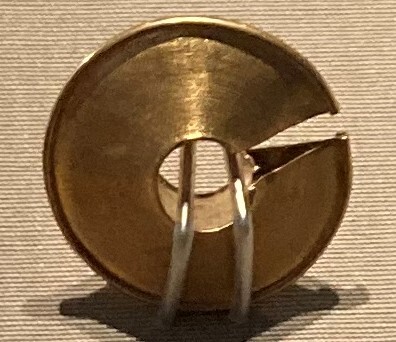
The soldered wires in the lock rings are so tiny they barely show in my photos. The enlarged one from the upper left of the photo above it may show the lines better, the curve. Such delicate, intricate work illustrates the fine skill of goldsmiths in this period. If they did this as Levaen did, they hammered the gold into a thin sheet, then rolled from the edge to create the wires and bonded them in place with soldering particles.
This small sample of the museum’s 800-700 B.C. goldwork that fits into my story’s timeline shows no brooch like the one my protagonist Levaen makes in the book, nor did I find anything like it. I began to worry about that, but Carisa, my daughter and beta reader, pointed out that there was no reason Levaen’s fictional goldwork should show up in the Dublin museum, and I remembered that the story presents Levaen’s brooch pattern as special in her own time. What the museum exhibits showed, especially the lock rings with their thin wires, was that the actual goldsmiths of that era were familiar with techniques like the thin wires and soldering Levaen uses to create her brooches.
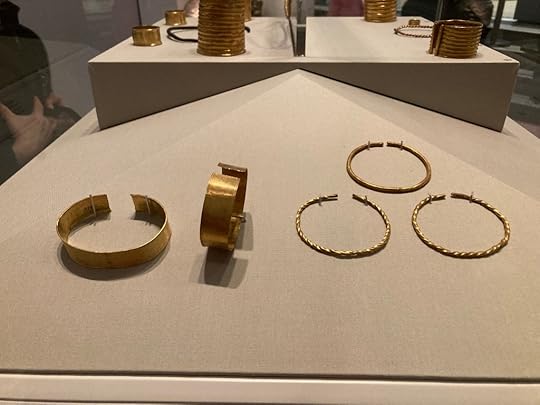 Going farther back to 1200-1000 B.C. are three twisted gold bracelets and two gold grooved bands.
Going farther back to 1200-1000 B.C. are three twisted gold bracelets and two gold grooved bands.
 And a gold torc with ribbed rings and bracelets from 1200-1000 B.C.
And a gold torc with ribbed rings and bracelets from 1200-1000 B.C.

One exhibit offered a portrayal of how some of these golden objects might have been worn. This illustration features goldwork from the Late Bronze Age, roughly 1000 to 500 B.C., a neck ornament like the one in the photo at the top of the post, along with ear spools of sheet gold, and arm and wrist bracelets pictured above.
Of course these items could have been worn by either men or women or both. There might have been chiefs or chieftainesses. Or perhaps the general public would have donned such brilliance for special occasions. We can only wonder and imagine.
There was so much more gold in the museum’s collection, but some bronze too, that caught my eye.
 Swords from 900-500 B.C. Some look like leaf-shaped Hallstatt swords but they’re not labeled as such.
Swords from 900-500 B.C. Some look like leaf-shaped Hallstatt swords but they’re not labeled as such.No one knows when the Celts came to Ireland. We only know the language came, so they must have come. But they would not have been in Ireland in any numbers at the time of my story. A few Hallstatt swords possibly came earlier, by trade or other means. Enough to tantalize but not to prove anything.
There’s no intrinsic method of dating metal, so dating depends on surrounding materials that can be dated. In fact, in at least one occasion they found a lunula in a wooden box, which identified the time of its use by testing the wood. Surely a precious object. Dating offered with the museum exhibits of gold and bronze would have been confirmed by surrounding material, but they give a broad span as noted in captions here.
Many objects in the exhibits are labeled as parts of the hoards that included them, deposits placed into bogs or lakes or streams. Why the ancients deposited such hoards, no one knows. Bogs may well have been lakes at the time of the deposits and later dried up, so all deposits may have been placed into the waters. Or some dry or party drained bogs may have been dug into and the items buried. Were the treasures cached in a time of escape from some crisis? Or were these offerings to their deities? All we can do is guess. We have no writing, no histories, to tell us.
The hoards weren’t all glorious gold. Many practical items were included. A lot of bronze. Practical axe heads, chisels, horns, cauldrons. And swords and spear heads.
Some items are just delightful objects like the one pictured below. I so enjoyed seeing it, I chose to share it here, even though it’s later than my story.
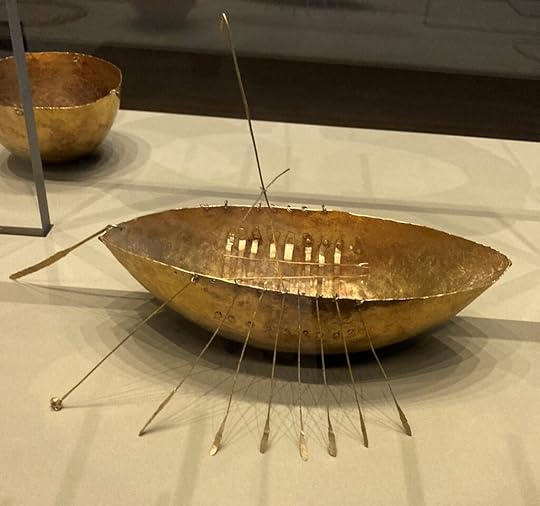 Miniature 7-inch-long gold ship with sailing mast and oars from the 1st century B.C.
Miniature 7-inch-long gold ship with sailing mast and oars from the 1st century B.C.NEXT: The Gold Mountains
May 23, 2024
Going There #2: The Crossing
I picked the place on a map where my book’s desperate character would make the Crossing to the next island, but I didn’t know the significance of the town called Bray when I chose the site.
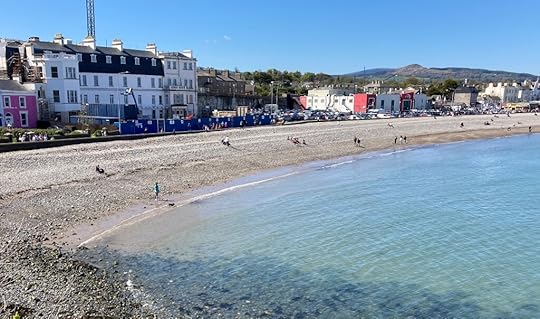
Young Irish goldsmith Levaen faces betrayal by her clan mother and her own father when they insist she save the island’s sacred peace by taking as her mate a man who threatens war unless she submits. She has fled her home, desperate to escape her plight. There’s a narrower Crossing to the north, but that’s a longer walk and her father may pursue her–with their dog to track her. She opts for the longer passage despite her fears of the long journey across the water. She has gone this way once before with her father. She must do it now on her own.
My journey to Bray was my second excursion on this trip to Ireland and unlike the tour to Newgrange described in “Going There: #1” here, I would do this one on my own.
I had researched the site on Google Maps and ways to get there, but I wanted to check with local sources for the best way to go. I had planned to explore Dublin over the weekend and go to Bray on Monday. But the forecast was for great weather on the weekend, so I decided to bump that plan up, given the iffy weather I’d experienced on the Friday tour to Newgrange.
On Saturday morning I stopped at the front desk in the hotel to ask one of the friendly people there what was the best way to get to Bray on Sunday. His face lit up. “Oh! It’ll be a perfect day in Bray tomorrow!”
I want to say here how much I loved my hotel in Dublin, the Castle Hotel where I stayed for eight nights. I didn’t think to take a photo of it, but their website is here with many photos. It’s an old Georgian building “set within nine elegantly restored Georgian townhouses.” The restoration has spiffed everything up while leaving the charm of finely molded woodwork, gracious windows and staircases (but with a modern lift).
Even more than the beauty of the building, though, I loved the friendliness of the staff–from the front desk to the two restaurants, and everyone else. The upstairs restaurant offered an amazing array of pastries, cereals, fruits, and more for breakfast. In the main downstairs restaurant, the Vault, Irish balladeers entertained us every night of the week. I dined there each night and enjoyed their music nearly every time so the wait staff soon began to treat me like a regular. One delightful young woman on the staff even gave me a hug when we happened to meet on busy O’Connell Street the morning I left.
So! Back to my visit to Bray! The man at the front desk of the hotel drew out a map and recommended that I take the train. He showed me the way to the train station and told me, “Watch for the spire.You won’t get lost on the main streets of Dublin if you watch for the spire.”

See that tall Spire rising into the sky behind the tree? This is O’Connell Street, the main thoroughfare of Dublin and that Spire can be seen from all around. It’s 390 feet high, made of bright, shiny stainless steel, and in a city where street signs are often obscure and street names may change from one block to the next, it can orient you when you might otherwise be unsure of your location.
I easily found the train station on Saturday and bought a ticket. The woman who sold it to me smiled and said Sunday would be a lovely day to visit Bray with the weather being so nice. What was it about Bray?
The train had the advantage over the bus because of the train route along the seashore. A lovely ride.

I caught the above shot from the train window. When the train finally pulled into Bray, last stop on the line, we still had a walk to get into the center of Bray and my Crossing on the far side. My hope was to climb up to the peak of Bray Head where a cross stood looking over the broad sea. If you look closely you can see it in the next two photos.

A seafront promenade followed the pebbly beach. That peak with the cross looked far.

No question how to find the way. The promenade moved right up the hill at the curve in the coastline. The cross still looked far.

Higher up, people were picnicking, and I got the full impression of what my character Levaen must have felt looking out on that wide sea she had decided to cross. Not in a ship. Not even a big boat. Just a simple currach. The currach in Levaen’s day was a narrow Irish boat with a frame of wood, like hazel rods and brush twigs, covered by animal skins, the raised pointed bow designed to take on the swells of the sea. Sometimes they carried a small sail to use if the wind was fair. Such boats were probably used by Neolithic settlers who crossed to the island long before. These hardy craft are still used today, but usually with wooden frames covered in canvas.
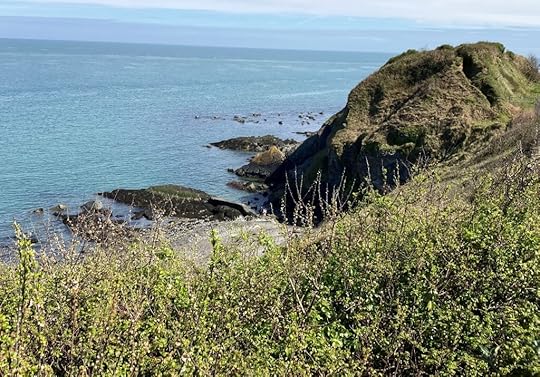
Just beside the green area shown in the previous photo I found this cove that fit my description, with a little rewording. Modern influences had no doubt changed it but this offered the impression of what might have been.
There was still the high point where that cross stood. Did I really need to go up there when I already had the feel of the place? I had worn my new running/walking shoes for this, and I found a staircase leading up in the right direction. Stairs and more stairs, and steep paths. I wasn’t even sure they led to that peak, but I supposed they must. I kept climbing.
I met a couple coming down and asked them, “Where do these steps go?”
“To the cross.”
Ah! “Is it far?”
He smiled. “Yes, it’s long.”

I kept going and found the wooded area above the Crossing where my protagonist Levaen might have camped out the night before she went down to the shore to meet the men who took passengers across. I stepped in among the gnarly trees, glad I had come this far. Yes, such a lovely woodland could have been here then. I could almost sense her there–afraid, determined.
Then I continued up the slope until I came to this.

That trail looked like an ankle turner. Maybe if I’d worn my high-top hiking boots I left at home because they’re too heavy. But not the low tops. I turned back. Would Levaen have had the good sense to skirt the peak and avoid such a landscape? Or was the landscape significantly altered in the 2800 years since the story’s timeline? It didn’t matter. The story doesn’t show that part. Her scene at this coast opens the morning she leaves her campsite in the woods to go to the sharp-edged dropoff and down a narrow trail to the cove.
I had found what I needed at Bray. It was time to work my way back to the train. The afternoon had warmed and I took off layers. An absolutely gorgeous day. It was after 2 o’clock by this time and I was getting hungry and thirsty. I’d seen ice cream and snacks along the beach. But I had reached the train station before I saw anything that appealed to me. There at the station a small shop had one raspberry scone left. I bought it and a drink to go with it. Scones were beginning to look like my Irish special lunch.
Back at the hotel I was so glad to find the man at the desk who had given me advice on getting to Bray and could tell him what a wonderful excursion it was and thank him for his advice. He was delighted and his eyes lit up as he commented, a bit wistfully, on what a fine day it was to go there.
That night at dinner I didn’t stay to the end of the music. I apologized to the head waiter and told him I had been to Bray so it was a long day for me. Then his eyes lit up and he asked if it was nice at Bray and when I told him how lovely the day was his whole expression warmed as if he could feel that sun shining on his own face. I was beginning to see that Bray was far more special to the Irish than I had supposed.
I’d just picked Bray to provide a coastal setting for the Crossing in my story, not knowing I had chosen a favorite getaway for Dubliners, if not the Irish from far about. I would later learn that Bray was one of the first seaside resorts in the country, going back to the Victorian era.

These pretty houses at Bray overlook that fine coast and give a glimpse of the historic nature of the place, if not as far back in history as I was imagining for my story. So it turned out to be kind of a twofer. I found what I needed for my story, and enjoyed a historic Irish resort as well.
May 18, 2024
Going There #1: Into Ireland’s Ancient Heart
It’s older than Stonehenge. Older than the pyramids of Egypt. Newgrange. More than 5,000 years ago Neolithic people with only stone tools built this mound with such precision that the rising sun on the morning of the winter solstice would stream down a long, narrow passage to the vaulted chamber of the interior and fill it with light. There beneath a meticulously corbelled roof the bones and ashes of their dead waited.

Two doors enter the passage. The one above receives the sunlight. The one below, partially hidden behind the carved kerbstone, receives the people. I was here with a tour group. I would soon go in.
No one knows what those carved symbols mean, and the guide told us the triple spirals have never been seen anywhere else. We offered our thoughts. I suggested life, death, and rebirth. The people in my stories of ancient Ireland would believe this.
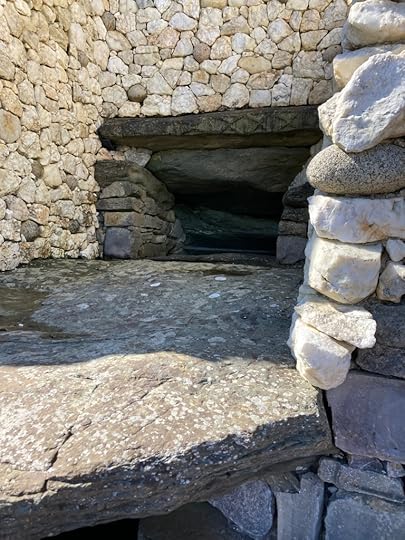

The photo of the upper door was taken for me by a nice, very tall man in my group. I took the lower one. That’s as far in as we were allowed to take pictures. The way is narrow. Sometimes you have to scrunch your elbows in. Sometimes you have to duck under low stone before you enter the inner chamber once visited by the ancients.
I was like a child before Christmas. I barely slept the night before my tour to this amazing site. The tour would also take me to another passage tomb in the same area, Knowth, and to the Hill of Tara. A worrisome drizzle followed our bus as we rolled out of Dublin, first stay on my overseas trip this spring. When I planned the trip I knew I would not rent a car this time, so I chose bases from which I could take tours or just excursions on my own by local bus or train.
I gave myself a day for jet lag and to explore Dublin enough to find my way to the place the tour bus would pick us up the following morning. This was my first tour of the trip. And one of the more important. When I read online about the Newgrange Tours by Mary Gibbons, I knew I wanted to take her tour. It was the right one. No question. But who knew on the 22nd of December when I reserved it what the weather would be on the 19th of April. I just had to hope.

The drizzle let up when we reached the Hill of Tara, the first stop on our tour. But it was blustery out. I had to forego the hat and pull up my hood. I was glad for every layer I wore. I had chosen Tara as an important site in my new book, this place of myths and legends and making of kings. I’d visited Tara once before, back in 1993, but I hadn’t retained a good sense of it. Pictures don’t do it justice. They don’t quite show how high it rests over the surrounding plains. I did remember the mound. It’s a passage tomb also, not as large or elaborate as Newgrange, but from the same era. The name “Tara” is apparently later than my story’s time but I use it, as I sometimes do when a place would be difficult to identify for readers without the familiar. I call is simply Tara, not the Hill of Tara.
Our group trekked across the rich green grass, and over the henges, the circular ditches and rims on the ground where ancient deeds occurred. It was evidently a gathering place for many years, and I used it so in my story. I imagined my character trekking across it with me and heard our excellent guide, Mia Craig, mention to someone that scholars believe Newgrange was only in use for 600 years. That concerned me. I had my people using it much later. When our group began to meet up at the gift shop before moving on to our next stop I saw her standing alone and walked over to ask her about that. She reassured me. “They don’t really know,” she said, “and there’s an old Irish saying, ‘You don’t want facts to get in the way of a good story.'”
We laughed together. I told her I tried to get things as right as I could, which was why I was back in Ireland. She didn’t think I should worry about using the site for my characters. Of course scholars can interpret the presence of objects. Not so easy to interpret the absence. That’s where I can fill in the gaps with my world-building.
The drizzle came back, windshield wipers on the bus working hard as our tour headed toward Knowth, another intriguing site along the River Boyne, this one with multiple passage tombs like chicks around a mother. But they can tell from its shape that the large mound in the center came after the others because its irregular shape accommodates them.

By the time we got to Knowth, again the rain stopped and we gathered around the local guide, a good-looking man with silver hair and bright blue eyes. He started by asking if anybody had been there before. I answered, “Not at Knowth but at Newgrange.” He asked when. I said 1993 and 2004. With a twinkle in those blue eyes he suggested I could probably give this talk as well as he. I said only if I could follow an old Irish saying our tour guide just told me about, that you don’t want to let facts get in the way of a good story.
He chuckled and said, “Well, we try to keep to the facts here.”
One of his comments startled me when he told about recent DNA studies which showed that the early Neolithic people who built these tombs came out of Anatolia, people with tawny skin and dark-brown eyes, whereas those who followed came from the steppes of Russia with their pale skin and blue eyes, like his. From my own studies I understood that the early Anatolians were likely worshipers of a Mother Goddess and may have been matriarchal, while those from the northern steppes worshiped sky gods and were patriarchal. My ancient series draws together the worlds of Minoan Crete and Ireland, so when he mentioned Anatolia I recalled reading that DNA evidence shows that the Minoans also came out of Anatolia.
Whoa! Were these people kin? Would their oral histories reflect similarities? It was mythologist Joseph Campbell who inspired me to bring the two islands together when he wrote of a second hearth west of Crete where at the same time as the Minoans the early Irish showed through their myths a similar culture with strong women and the worship of a Mother Goddess. Now the DNA evidence in Ireland appeared to confirm that connection. A thrilling discovery for me.
Next stop on the tour was the Newgrange visitor center. We were getting close to the main show. Drizzle picked up again. The visitor center was wonderful, more elaborate than in 2004. I don’t think there was a center in 1993. We just drove up to the site. Now they would take us from the center on special buses on a predetermined schedule. We wore pink bands on our wrists to indicate our time slot. The schedule gave us time for lunch in their pleasant lunch room and to visit the displays. I didn’t want a big meal so I opted for a scrumptious raspberry scone with raspberry jam. They even heated it for me. Wonderfully decadent.
After lunch I especially enjoyed a walk-through at the visitor center where shadowy deer and birds moved among silhouettes of forests. Nice illusion. Among the trees several screens showed films of the three significant passage tombs along the River Boyne–Newgrange, Knowth, and a third that isn’t open to the public, Dowth. The High Tombs of my ancient Irish stories. A drawing portrayed a dog, its appearance based on bones found there. He looked just like the dog in my new story that I imagine resembling an Irish Wolfhound, though the breed is much newer. There he was! My dog Tormey!

We crossed the River Boyne on our walk to the Newgrange buses that would carry us to the site, a skiff of mist in our faces, heavy skies overhead. I had scoured Google maps and online photos, trying to see how big a river this was. Could a person ford it on foot? Or would they need boats or rafts? On that bridge I got my answer. I would keep my character on a boat.
When our bus pulled in to Newgrange the clouds parted like an opening curtain and a bright sun came through. I climbed out of the bus, looked up and saw it, white quartz face aglitter. The marvel that is Newgrange.
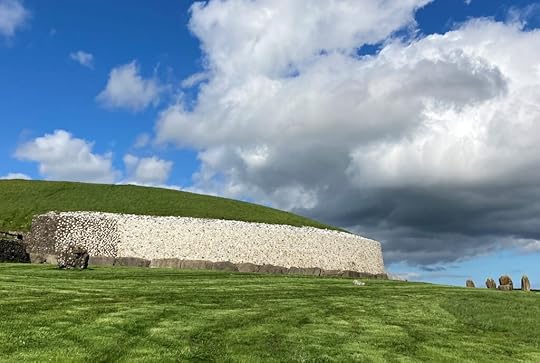
This is the place where my Clan of the Grey Wolf lives, their clan mother a dear friend who’s like a second mother to my protagonist Levaen.
The local guide split our group to take half at a time in the passage into the interior of the mound, while the other half were free to wander the site. Just what I had hoped. I wanted to wander around and get the lay of the land. What about my description from a ridge above? Well! There isn’t a ridge above. The mound lies on the ridge itself and the encircling pillar stones are much lower in the back, the kerbstones at the mound’s edge following the downward slope until they are completely covered with turf. The river is visible, but distant. Revisions I’ll need to make.
The mound had long since collapsed when excavations in the 1960s and 70s brought it back to its original state as nearly as could be determined through meticulous study of what they discovered. From my reading it appears that the passage and vault with its corbelled roof were basically intact, although some of the uprights in the passage were leaning and had to be straightened. It’s a bit more complicated, but that seems to be the gist of it. Scholars still argue over the white quartz facing, but they found a pile of the quartz in front that must have been used somehow, and quartz facings from the period have been found on other sites. It certainly offers a dramatic impression.
Finally it was my turn to go in. My heart raced when I stepped inside the narrow passage, scrunched my shoulders, dipped my head. I’m a little claustrophobic, and we were warned about that. But I knew I could do it. I had done it before. Somehow memory slips away and the moment becomes new. I drew a full deep breath when I got through the passage and entered the spacious vault. I looked up at the intricate layers of perfect corbelled stones, each course of slabs partly resting on the one below, up to the capstone high above me. The interior is shaped like a cross with the elongated passage as the shaft, three extensions inside, one to the left, one to the right, one straight ahead, where stone basins held the bones or ashes.
For the tour they turned out the lights and shone a single light down the passageway to represent the rising sun on winter solstice that would fill the chamber with light. In my story that light embraces the spirits in the bones or ashes and carries them out the passage to lift them to the stars where they will await rebirth. Now I felt the wonder of it.
When the tour was over I exclaimed to Mia, our tour guide, “That was the best!”
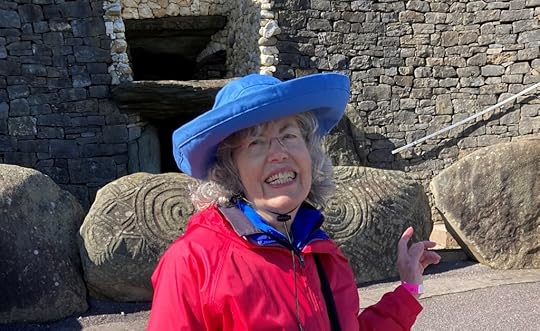 Photo by tour guide Mia Craig
Photo by tour guide Mia Craig

NEXT: The Crossing
May 15, 2024
Going There 2024 – Overview
Every place seems to have a certain personality, a character you can only know in its presence, so when I write a story and spend any amount of time in a particular place I want to reflect the sense of it. That’s why I want to go there, to know it, and thus better knowing it, let my reader know and feel what I felt there.
As my followers may remember I recently completed a historical novel set in ancient Ireland and surrounding lands. I had already visited many of these places when researching the series that’s related to this story, but happenings differ and characters may look at their world from different perspectives. Can she, for instance, see the river from there?

This is Newgrange, the ancient passage tomb built some 5,000 years ago by Neolithic people who walked there long before my characters. It’s older than Stonehenge, older than the pyramids of Egypt. My story opens in 750 BC. And yes, she can see the river from this spot outside the tomb. She won’t try to ford it, though. It’s much too deep and swift. I’ve seen that now. She’ll take a boat across, as I’d written it.
I have visited Newgrange twice before, in 1993 and in 2004, but not only was I working on different stories then, I did not have a digital camera that would allow me to share such a photo here on my website or on other social media. I carried my small Nikon digital camera I took on my 2018 trip and a newer iPhone than I had then. And I sought out better pictures as well as research photos to help me hone my descriptions.
Late last year I began contemplating this trip. I decided I would limit it to Ireland, home of my protagonist, and Hallstatt, Austria, homeland of the proto-Celts, where she spends a considerable amount of time. For quick stops I can take trips by Google Map, but for long stays I want to soak a place in. I had visited the charming village of Hallstatt once before in 2006 when I traveled there with my Austrian friend Tilly. But I was researching a different book then, one that fell by the wayside. Now I wanted to see Hallstatt with the new book in mind.

I had forgotten how steep the mountains, how stark the limestone cliffs, how sparkling the lake. Yes, the quaint houses will ever climb that bluff, the iconic church steeple pierce the sky. But I wandered the single street, climbed the many steps, found the waterfall I knew was there and included in my story. I enjoyed a sense of it I did not have before.
I didn’t rent a car so in Ireland I picked bases from where I could take tours or just go on my own by bus or train. I started with eight nights in Dublin. Then to Limerick for five nights. And a five-night return to the heart of my story, Rosscarbery, staying at the Rosalithir B&B with my wonderful hosts Catherine and Finbarr O’Sullivan. My third visit with them. The last visit in 2018 had been much too short and left me with critical questions on the setting. The new visit would answer questions I didn’t even know I had. A vital visit for understanding the lay of the land. And the water. The beach.

This was the rugged eastern headland I needed for one of my stories. Golden Eagle Bay in the world of my characters was broader than I thought on my brief stop in 2018. It took me several walks, especially over the newly improved Cliff Walk on the western headland to figure it out. From there I looked back and the setting became quite clear, the revisions I would have to make–not on the new book but on several books in the series.
It was moments like this that I confirmed my need for this trip. Yes, it was time to travel again. Yes, I wanted to revisit these special places, but with that discovery and more I found answers to questions I hadn’t thought to ask.
In the next several blog posts I’ll share the journey–from Dublin to Salzburg, Austria, where I stayed a couple of nights on either side of my Hallstatt excursion because of its access to an airport. A lovely spot itself where I stayed in an amazing 17th century seminary partially converted into a hotel. It even had a domed roof.
I’ll add the posts to the new “Going There” list on the sidebar as I publish each one.
February 24, 2024
A Close Hawk Encounter
Yesterday I had a close encounter with a hawk like this female Northern Harrier.
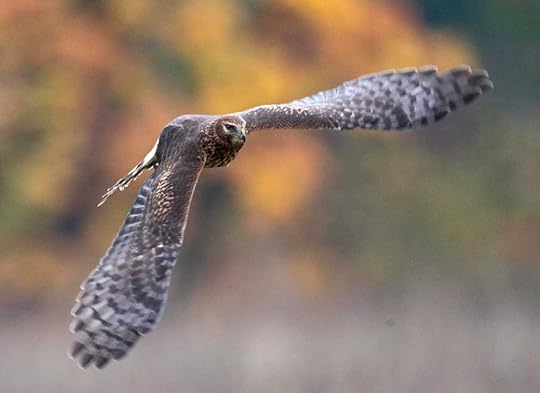 Female Northern Harrier – Robin Loznak photo
Female Northern Harrier – Robin Loznak photoI was taking my daily walk on a beautiful sunny afternoon, trekking uphill past the farm’s upper barn to the broad field above. As I occasionally do on the uphill climb I stopped for a breath and turned around to observe the panorama below me and to enjoy the glorious perspective that widens with each step in elevation–the forested mountain range in ranks from dark-green to blue, the verdant middle plain, the nearer skeletal oaks.
With startling suddenness the huge hawk came up behind me and swooped over my left shoulder and down the road in front, maybe three or four feet off the ground, shimmery rich-brown wings spread. Soundless. Hovered not six feet away. No sign of fear, though she had to know I was there. The moment felt long, time suspended. As I watched in awe, she made a sharp right turn and flew out over the green slope beside me, the bright-white clump of feathers on her rump clearly identifying her as a Northern Harrier. The brown wings and back suggest she was probably a female. She seemed to float above the grass, tilting this way and that, then turned again and soared downhill out of sight.
I caught my breath in wonder.
 The place
The placeReaders who have followed my work may recall my intrigue with the white hawks that seemed to be harbingers of good news from time to time, beginning with the one that swept in front of my office window, then flew low above the road as if leading my grandchild and me up the hill. Leading where, we didn’t know, but it felt quite magical. A hawk like him would appear one day when my son-in-law Robin had his camera handy, just in time to be added to pictures in my book A Place of Her Own.
Some of the Northern Harrier males that visit our property are white on the underside with the black wing tips and pale ashen backs, like the one below that Robin photographed more recently. When they fly they appear quite white. The females can be mistaken for juveniles, which are also brown on backs and wings, but females have whitish undersides with brown streaks like the one in the top photo, while juveniles have buffy undersides without the streaks. These birds are commonly called Marsh Hawks. My thanks to Robin for all these hawk photos.
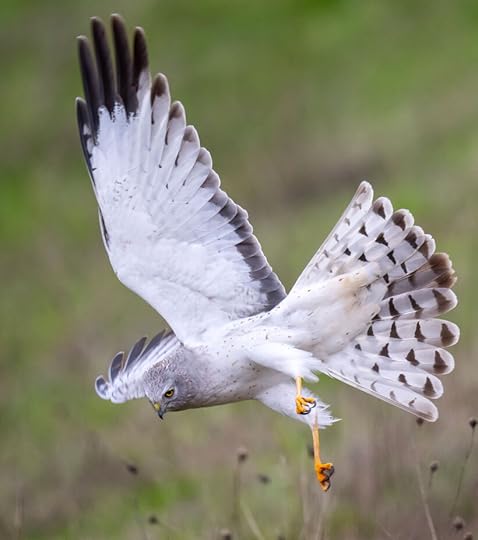 Male Northern Harrier – Robin Loznak photo
Male Northern Harrier – Robin Loznak photoThe hawk that arrived in time for the book, shown below, also has the white coloring that led me to call them white hawks.
 Male Northern Harrier, picture from the book – Robin Loznak photo
Male Northern Harrier, picture from the book – Robin Loznak photoI hope the lovely one that came yesterday promises good news. Her presence certainly lifted me up.
January 28, 2024
Sign of Spring
Daffodils are budding out and it’s still January! Temperature outside my Oregon home hit mid-60s by noon. See the swelling buds? Are these signs of an early spring? I’ve been needing spring. I hope it is.

This row of daffodils always blooms before the others near my house. Every year I look to them for a sign of hope that winter is passing and spring will soon come.
Of course in January we know winter can still throw plenty at us. Daffodils will be okay. They’re tougher than they look. They can take whatever weather they meet. We’ll be okay too, though we need these little signs of hope. Some sooner, some later.
Last year they were so late. Remember my daffodil saga last year when these only started to bud out on a snowy March day? Then the delight when the first bloom finally appeared? I’ve been feeling winter this year. Some years it just seems long whether it is or not. In any case I am definitely ready for an early spring.

I took the closeup this morning, the other late this afternoon. Thank you, little daffodil buds, for a boost of hope today.
December 15, 2023
Roiling Fog Amid Relaxing Days

The fog finally lifted this afternoon for a nice walk on the mountain. I love to see it roiling up this way. I remember when I lived in San Francisco how it would roll across the bay. Here, there’s the river.
I’m in rest mode on the writing. We authors are advised to maintain balance in our work–writing, reading, social media, and so on. I think it’s meant to be balance weekly or at least monthly. I’m afraid I don’t quite meet that. When I’m deep into writing I avoid reading other books, partly because I get so caught up in reading I don’t want to quit, so that would surely slow my own projects. I just delve in and let my stories take me.
But when I complete a major project I do treat myself to a reading binge. That’s where I am now. I just completed a polish on the series behind my new book set in ancient Ireland. I had roughed out some major changes to the series before completing the new one. Now those changes are polished.
My binge focus at this time is relaxing with Jane Austen, always a delight.
That said, I always try to walk every day. I need that, not only physically but mentally. So often ideas come to me on these walks. But today I just want to share this outing. No major thoughts incoming. Just joy in the beauties. I thought the fog would never lift this time, but here comes the sun.
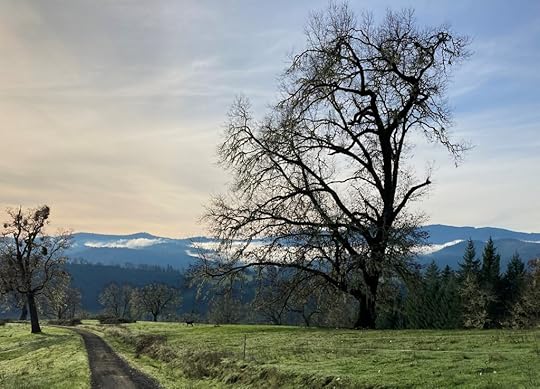
If you look close, left of center, you’ll see I have company.
December 4, 2023
For the Love of History
As a historical novelist I have my favorite eras, but I love history across time. I’ve always wondered. What was it like? How would it be to live in another time and place? So when I visited my kids in Kansas for Thanksgiving and my daughter Christiane had a faculty meeting right across the street from a museum, my grandkid Aspen and I opted to visit it while Christiane attended her meeting. Christiane is an Associate Professor of Animation at Kansas City Art Institute. I had no idea what an amazing exploration of history we were about to enter at the Nelson-Atkins Museum of Art.

Knights in shining armor offered a show stopper right at the beginning. I should have asked Aspen to stand close by to give an indication of size. But the knights displayed are big men. The horse was massive, despite the appearance of dainty hooves. I grew up with a good-sized horse, but this horse would have towered over her. This was a model, of course, but illustrated the size required to function under all that metal.
From knights in armor we swept way back in time to this figurine, which may have represented the Mother Goddess worshiped across Europe and into Asia from the Paleolithic to the Bronze Age. This one, created in marble, is in the museum’s Greek collection from the Cyclades, mid-third millennium B.C. The museum literature suggests that due to the sexual emphasis the figure may have represented fertility. Since such figures are often found in tombs it might have been placed there to help the dead reach the next step in life’s continuing cycles, that of rebirth. I present similar beliefs in my upcoming stories of ancient Ireland and Crete. So I was excited to see this.


From the Cyclades of Greece we went to ancient Egypt to visit numerous sarcophagi and an actual mummy, with quite an amazing display of ancient Egyptian art.
And Asian art. See the Guardian Lion below. Another picture I should have taken with Aspen nearby to show its size. I’m guessing he’s about five-foot tall. He’s from the Tang Dynasty, probably around 681 A.D., made of gray limestone. He’s impressive. If you take a close look you may see the graffiti carved into his legs. Even back then.
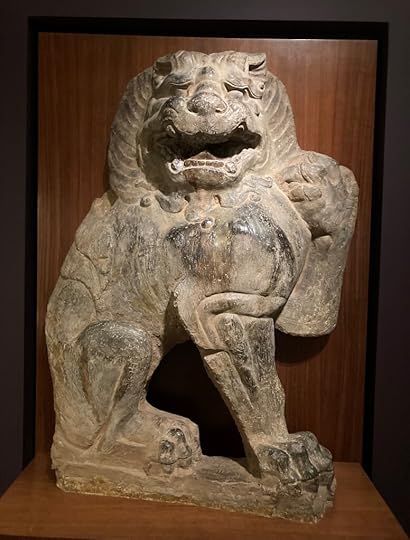
There was so much more. Fine displays of Native American art. Exquisite paintings. Pottery. Chinaware. It was an afternoon well spent.



